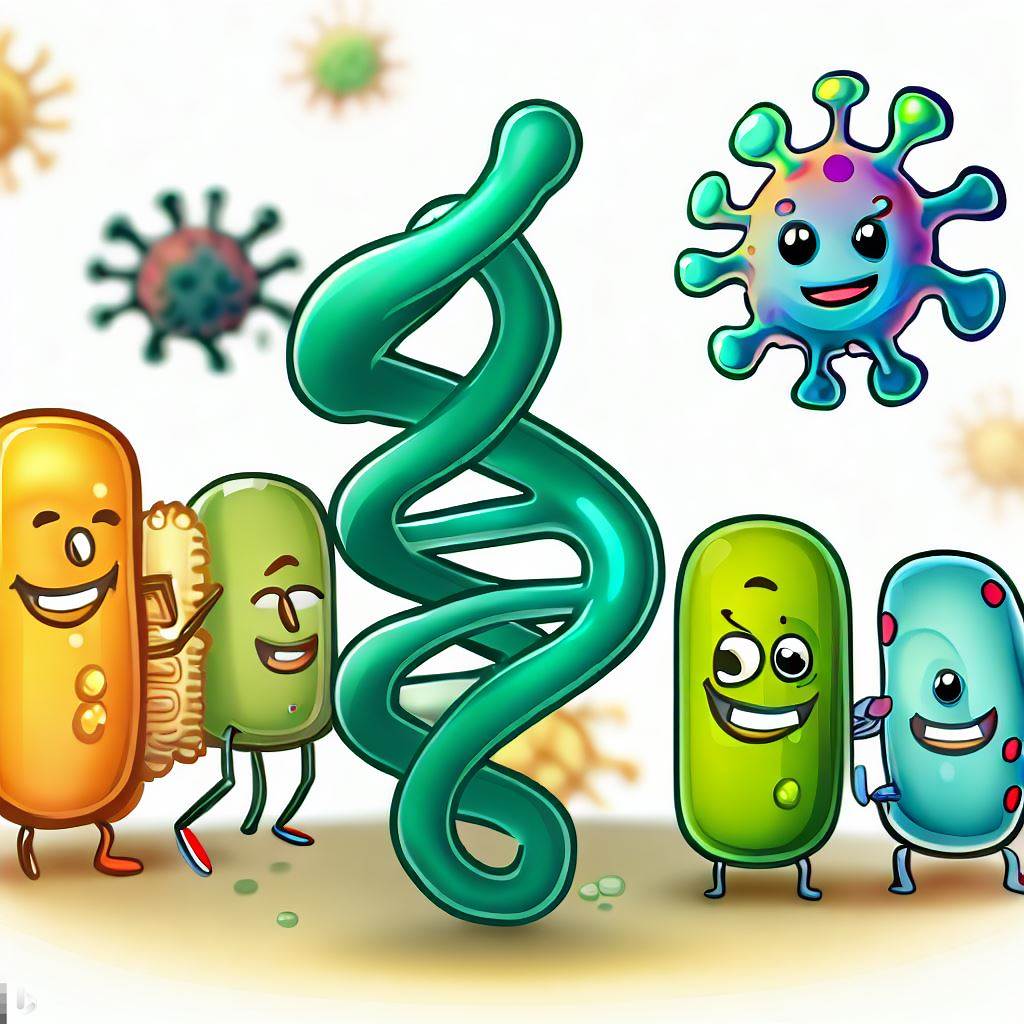Understanding the concept: Phage transduction
Imagine bacteriophages as tiny, virus-like entities that infect and replicate within bacterial cells. These bacteriophages are like genetic couriers, responsible for transferring specific bacterial genes from one bacterial cell (the donor cell) to another (the recipient cell) through a process called transduction.
Here’s how it all happens at a molecular level: When a bacteriophage infects a bacterial cell, it injects its own genetic material into the cell. As part of the viral life cycle, the bacteriophage replicates inside the bacterial cell, producing new viral particles that contain a mix of viral and bacterial genetic material.
Sometimes, during this replication process, errors occur, leading to the packaging of bacterial genes into newly formed bacteriophage particles. These bacteriophages, carrying a segment of the bacterial genome, are known as transducing phages.
Now, these transducing phages can leave the donor cell, carrying the bacterial gene segment with them. They then encounter other bacterial cells, which could be of the same or different species, and infect them.
Once inside the recipient cell, the bacteriophage’s genetic material is released, and the bacterial genes it carries become part of the recipient cell’s genome. These new genes can bestow advantageous traits upon the recipient cell, such as antibiotic resistance or increased virulence.
Transduction can occur in two different modes: generalized and specialized. In generalized transduction, any random bacterial gene may be transferred by the bacteriophage. On the other hand, specialized transduction involves the transfer of specific bacterial genes, often those encoding crucial functions like antibiotic resistance or virulence factors.
Generalized and specialized bacteriophage transduction well explained
This phenomenon of bacteriophage transduction plays a significant role in bacterial evolution and the spread of important genetic traits across bacterial populations. It facilitates the rapid exchange of genetic information, allowing bacteria to adapt and survive in various environments.
However, as with any evolutionary process, there can be downsides. The acquisition of antibiotic-resistance genes through transduction can lead to the development of drug-resistant bacteria, making infections more challenging to treat.
Understanding bacteriophage transduction is crucial in the study of microbial genetics, as it provides insights into how bacteria acquire new traits and the potential consequences for human health. By exploring this fascinating process, scientists can develop strategies to combat antibiotic resistance and design more effective treatments for bacterial infections.

How was transduction discovered?
The discovery of transduction dates back to 1951 when Joshua Lederberg and Norton Zinder were investigating recombination in the bacterium Salmonella typhimurium using techniques previously successful with E. coli. They worked with two different strains: one lacking the trp and tyr genes (the− trp− tyr− strain) and the other lacking the met and his genes (met− his− strain). When these strains were separately plated on a minimal medium, no wild-type cells were observed.
However, when the two strains were mixed together, something intriguing happened. Wild-type cells emerged at a frequency of about 1 in 105. This occurrence resembled recombination in E. coli, where genetic material is exchanged between bacteria to produce new combinations of genes.
But, the researchers noticed something peculiar in their U-tube experiment. In this setup, they prevented direct cell contact (conjugation) between the two strains by using a filter to separate them. Despite this separation, recombinant cells still appeared.
Curious about this unexpected result, they experimented further with the filter. By varying the size of the pores in the filter, they discovered that the agent responsible for this gene transfer was about the same size as the known temperate phage P22, which infects Salmonella.
Through extensive investigation, they found that the filterable agent and P22 had identical properties, such as size, sensitivity to antiserum, and immunity to hydrolytic enzymes. This evidence led Lederberg and Zinder to a groundbreaking realization: they had not merely confirmed conjugation in Salmonella but had uncovered an entirely new mechanism of gene transfer mediated by a virus. They named this process “transduction.”
In the lytic cycle of this virus, some viral particles pick up genes from the bacterial host during replication. These genes are then transferred to another bacterium upon infection, where the virus inserts its genetic contents. This unique process of transduction has since been shown to be quite common among both temperate and virulent phages, expanding our understanding of how genes can be shared and exchanged among bacteria through the help of viral agents.
Types of phage transduction
Transduction can be categorized into two types: generalized and specialized. Generalized transduction involves phages that can carry any segment of the bacterial chromosome without specific restrictions. On the other hand, specialized transduction is carried out by phages that can only transfer limited or specific parts of the bacterial chromosome, with certain regions being favored for transfer.
1. Generalized
In the process of generalized transduction, a bacteriophage plays an unexpected role as a genetic courier between bacterial cells. Here’s how it happens:
When a bacteriophage infects a bacterial cell, it takes over the cell’s machinery to replicate and produce new virus particles. However, sometimes, during this replication process, accidents happen. Instead of packaging only viral DNA, a few phage particles mistakenly pick up fragments of the bacterial cell’s own DNA.
Now, these “transducing phages” are like tiny envelopes carrying secret messages (bacterial genes) from the donor cell (the bacteria whose DNA is being carried). They are ready to deliver these genetic parcels to other bacterial cells they encounter.
When a transducing phage binds to a new bacterial cell, it injects the genetic material it carries. Imagine it’s like the phage delivering a package to a new house. But here’s where things get intriguing – the bacterial cell, the recipient, now finds itself in a unique situation.
With the injected genetic material, the recipient cell becomes a “merodiploid” This means it now has two sets of similar genes – its own original ones and the ones from the donor cell, delivered by the transducing phage.
In some cases, these new genes may just lie dormant in the recipient cell’s genome, not doing much. But in other situations, they can be integrated and become active, influencing the recipient cell’s characteristics and behavior. This can lead to the acquisition of new traits that the recipient cell didn’t have before, all thanks to the genetic delivery service provided by the transducing phage.
Generalized transduction thus serves as a remarkable mechanism for bacterial cells to exchange genetic information and potentially acquire new abilities. It’s like a genetic adventure where viral couriers shuffle genetic content between bacteria, paving the way for microbial communities to evolve and adapt to changes in their environment
2. Specialized
Specialized transduction takes place during the lysogenic cycle of bacteriophages, where the virus exists in a dormant state within the bacterial host. Unlike generalized transduction, specialized transduction is a more precise process, thanks to the action of a specific enzyme system that facilitates recombination between phage regions and the bacterial chromosome.
In this remarkable process, the phage typically integrates itself into the bacterial chromosome at a specific point, ensuring consistency in its attachment site. When the lytic cycle is triggered, usually by factors like exposure to ultraviolet light, the prophage excises itself from the bacterial chromosome. Remarkably, this excision occurs at precisely the correct point, leading to the formation of a normal circular phage chromosome.
However, very rarely, the excision process may go awry, resulting in phage particles that not only carry nearby bacterial genes but also leave behind some of their phage genes.
An excellent example of specialized transduction is seen with the phage called Lambda (λ). As a prophage, Lambda always inserts itself between specific regions of the host chromosome, namely the “gal” region and the “bio” region. Consequently, in transduction experiments involving Lambda, only the “gal” and “bio” genes can be transduced.
The transduced phage particles end up defective due to the phage genes left behind during the excision process. They are referred to as λdgal (λ-defective gal) or λdbio particles. However, these defective particles can still carry nearby bacterial genes within their phage heads and infect other bacteria.
In a double infection scenario, where a second, normal phage particle is present, the λdgal particle can integrate into the bacterial chromosome at the attachment site of Lambda. As a result, the “gal” genes carried by the defective phage are transduced into the second bacterial host.
This mechanism of transduction is limited to genes located near the original integrated prophage, making it a specialized process. It allows for the precise transfer of specific genetic information between bacterial cells, contributing to the diversity and evolution of bacterial populations. Specialized transduction provides us with valuable insights into the intricate interactions between phages and bacteria, enhancing our understanding of the molecular mechanisms that underlie gene transfer in the microbial world.
What distinguishes generalized from specialized transduction?
Generalized transduction and specialized transduction are two distinct processes by which bacteriophages (viruses that infect bacteria) transfer genetic material between bacterial cells. Here’s a breakdown of how they differ:
- Occurrence: Generalized transduction takes place during the lytic cycle of a virulent bacteriophage. In this cycle, the phage infects the bacterial cell, replicates inside it, and then bursts the cell to release new phage particles, ultimately leading to the destruction of the host cell. On the other hand, specialized transduction occurs during the lysogenic cycle of a temperate bacteriophage. During this cycle, the phage can integrate its genetic material into the bacterial genome, becoming a prophage and living in a dormant state within the host cell.
- Acquisition of Host Bacterial Genes: In generalized transduction, the bacteriophage has the opportunity to accidentally pick up random fragments of the host bacterial chromosome during the process of phage assembly. This occurs when phage particles mistakenly incorporate bacterial DNA instead of solely viral DNA. As a result, the transducing phage carries a diverse range of bacterial genes.
In specialized transduction, the bacteriophage, which has already integrated into the bacterial genome as a prophage, specifically acquires only certain restricted segments of the host chromosome. During the excision process, when the prophage leaves the bacterial chromosome to initiate the lytic cycle, it occasionally takes adjacent bacterial genes along with it.
- Mechanism of Transduction: In both generalized and specialized transduction, the transducing phage contains fragments of the host chromosome. During the next infection, when the transducing phage injects its genetic material into a new host cell, the DNA from the previous host can recombine with the new host chromosome. This incorporation of foreign genetic material can influence the characteristics and behavior of the recipient cell in both types of transduction.
.
Transduction occurs when newly forming phages acquire host genes and transfer them to other bacterial cells. Generalized transduction can transfer any host gene. It appears when phage packaging accidentally incorporates bacterial DNA instead of phage DNA. Specialized transduction is due to faulty separation of the prophage from the bacterial chromosome, so the new phage includes both phage and bacterial genes. The transducing phage can transfer only specific host genes.
what is unique about transduction compared to normal bacteriophage infection?
Transduction stands out as a unique phenomenon compared to normal bacteriophage infection. In typical phage infections, the virus infects a bacterial cell, causes it to lyse or burst open, and then releases new phage particles to infect other cells. However, in transduction, the story takes an unexpected turn. Instead of simply destroying the infected cell, the bacteriophage becomes a genetic messenger, shuttling pieces of the bacterial DNA from one cell’s chromosome to another.
It’s like a molecular delivery service, transporting bacterial genome fragments between different bacterial cells. This distinctive process of genetic exchange sets transduction apart from the usual phage infections, where there is no transfer of genetic material between bacteria. Transduction allows for the horizontal transfer of genetic information, promoting genetic diversity and adaptability among bacterial populations.



